By Branko Bogdanovic
The history of the Yugoslav contingent of German select-fire Mauser pistols, i.e. the 7.65mm, 7.63mm and 9mm (Luger) Mauser Schnellfeuer Pistol of the 1930s has been recorded several times by many authors. Most of this information is only partly correct.
From 1932 to 1935 the Mauser automatic pistols were really tested in Yugoslavia in calibers 7.63×25 mm (Mauser) and 9x19mm but modified according to the requirements of the Yugoslav Artillery-Technical Department.
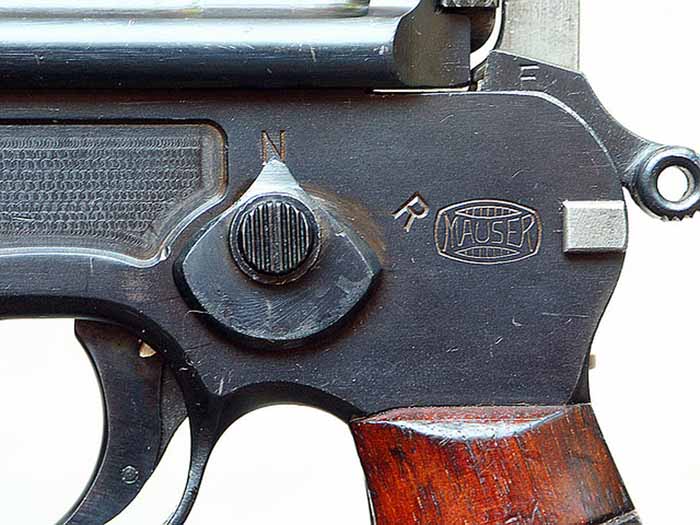
About this contingent the most accurate data are presented by authors Weaver, Speed and Schmid: ”…According to Thierry Gousset of Niort, France, three pistols were taken by the French from the Mauser factory shortly after the war… The second of the three items… is a rare and unusual early Schnellfeuer, serial no 3,112, chambered in 7.63mm and so marked on the special barrel, which appears to have been a preliminary sample for an order for 100 units chambered in 9mm Parabellum which were sold to Yugoslavia for troop trials in the 1933-34 period.
“This pistol displays two features that were not used on later Schnellfeuer models. First, the barrel is a separate component, threaded into the receiver… Secondly, the front sight… is a separate dovetailed unit which may be drifted to either side for windage adjustment.
“According to information received from Rolf Gminder, there was apparently some problem with the spring tension settings on these early pistols, which resulted in the actions becoming battered when subjected to extensive full-auto fire during tests in Yugoslavia. Although this problem was swiftly corrected in later production, the Jugoslavs did not order any more of these pistols.
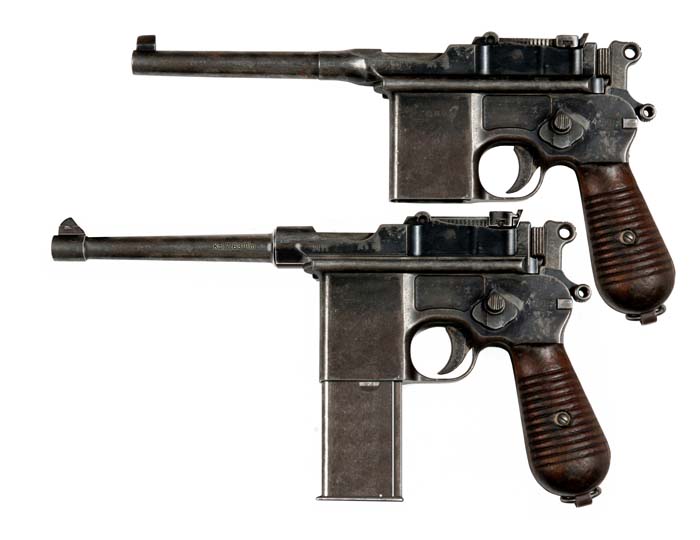
“Jon Speed advises that he has not located any archival Mauser documentation supporting a sale/offer of C96’s to Yugoslavia”.
At first glance, it seems surprising that the Yugoslavs took the Mauser automatic pistols into consideration at all, knowing that this weapon had not been introduced as a service weapon by any other army. New archival material relating to the German automatic pistols designed for Yugoslavia, reveals the truth about this issue. This decision was influenced by the needs of both the Yugoslav Army, which most certainly were the results of their reorganization and the favourable financial terms offered by Germany to Yugoslavia. Private contacts with politicians and bankers of Belgrade were of importance too.
The Yugoslav General Staff in 1931 took into consideration for the first time the project to create Special Forces equipped with proper weapons. Primarily these were the Mountain units, and later the assault or Chetnik troops were planned and paratrooper forces as well.
Official interests of the Mauser factory before the military and official circles in Belgrade were represented by Damjan Brankovic and his deputy, Mr. Veljovic. Brankovic started promoting the Luger P-08 pistols first and the Mauser-Schnellfeuer afterwards. In the course of 1931 he connected the German representatives with one of the most influential politicians – Milan Stojadinovic. In order not to be openly involved, Stojadinovic transferred all contacts to Jovan Gasic, the Chief of his Cabinet. Gasic established the relations with the members of Artillery-Technical Committee as well as with Colonel Petrovic, the director of V section of the Military-Technical Institute at Kragujevac. According to a report by French Military attaché of September 24, 1935, the German Government directly offered to Belgrade to compensate the debts by a delivery of armaments worth 10 billion dinars. The General Staff was considering the idea of placing an order for the Mauser pistols included in this sum too, as these pistols were being tested at Kragujevac already for three years.
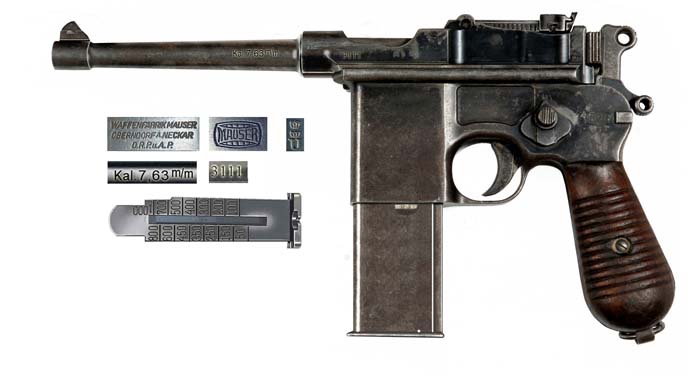
The Beginning of the Cooperation
Immediately after World War I, the Mauser factory started preparations for entering the new potentially large markets of the Kingdom of SHS/Yugoslavia. The first step was to protect the patent rights on their own most interesting products, including all Mauser Pistols. The preparation consisting of the patent rights protection was initiated by Mauser’s agents in Belgrade who came to know that a new competition for a service pistol was in prospect.
Indeed, in late 1931 the competition was announced in time of a pressing need for new pistols but also coincided with the need for arming the newly founded mountain regiments. Entirely unofficially and before the competition was announced, many firms, primarily the Spanish ones, had offered a variety of pistols to the Yugoslav Ministry of the Army. Also unofficially, these weapons were trialed without prejudicing any decision at all. The Mauser factory was also ready to accept a similar informal presentation of its automatic pistol. Damjan Brankovic was rather optimistic in this regard and a little bit hastily advised to take into consideration the possible financial aspects regarding the arrangements with Yugoslavia, as soon as possible. In a confidential letter from July 18, 1932, which he sent to Oberndorf, he writes that the Spanish automatic pistols have the same ballistic performance as well as German. Nevertheless, they are cheaper than the German weapons, and Mauser will probably offer a new, lower price.
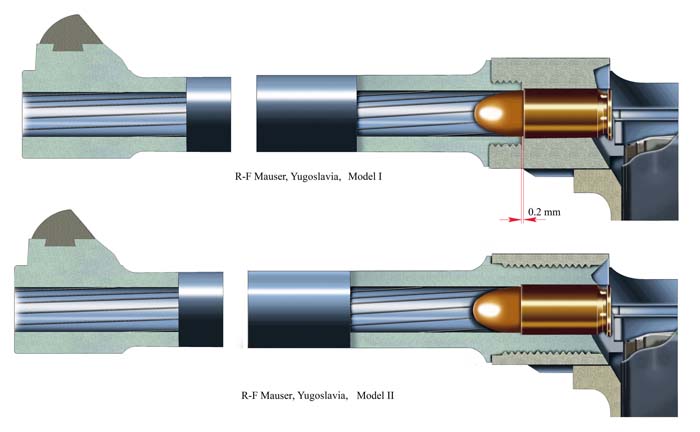
Surprised by the Spanish competition, management of the Oberndorf factory immediately took all measures to discredit the undoubted copy of Mauser-Schnellfeuer’s. The Technical Department of ‘Mauser’ on July 22 and 23, 1932 submitted a report to its sales department, i.e., Director Frosch, about the ”Royal” pistol that was already tested in Yugoslavia. This letter lists all the disadvantages of the Spanish arms in relation to the German original. After reviewing the Spanish pistol that was purchased by the company ”Genschow,“ concluded that the ”Royal” does not have all improvements implemented in the German automatic pistol. Original Mausers had 10- and 20-round detachable box magazines while the ”Royal” has a 10-round integral charger-loaded box magazine. Also, on the German model, was located a Univesal Safety, which is patented in several countries. Pistols with detachable box magazines have a special construction of the bolt locking block. When the breechblock is pulled back, the hammer’s head rises into a lug’s notch, axially placed at the back end of the breechblock and on its under-side, and holds the breech open and the breechblock is caught by the hammer’s head. When the pistol is loaded with a detachable magazine, it remains unchambered until the breechblock is pulled back and released. Finally, the German select fire pistol had the lock frame, bolt lock, hammer, cachting lever, lock frame cachting lever and bolt recoil spring stop made of chrome-nickel steel of the finest quality. Thus, the life expectancy of their arms was longer than the Spanish guns.
According to the agreement between the Ministry of the Army of the Kingdom of Yugoslavia and the Mauser factory’s representatives in Belgrade, the decision was made to inspect the standard Mauser-Schnellfeuer pistols in 7.63mm and 9mm (Luger) calibres without any changes.
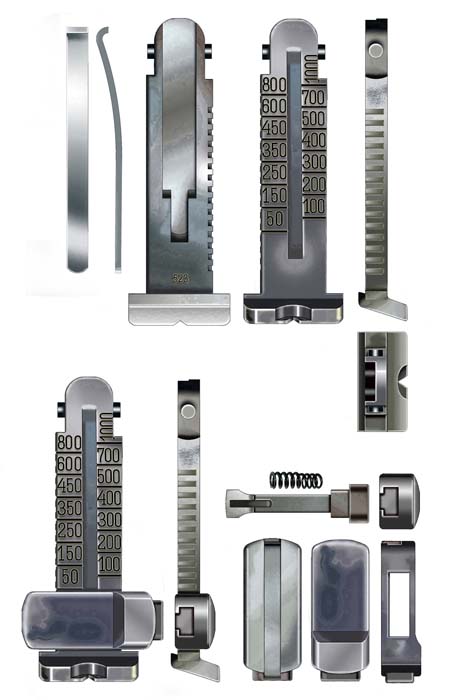
The Obernodrf factory managers sent Josef Nickl and Alex Mauser (one of the managers) to the Military-Technical Institute wherein the weapons were to be inspected. Josef Nickl stayed in the Jadran hotel in Kragujevac and from there on November 17, 1932 he informed director Wirthle that the pistols and detachable box magazine, necessary for trials, arrived in Yugoslavia.
The first trials at the Kragujevac factory internal range were conducted on December 26, 1932 and on January 5, 1933. Alex Mauser submitted a detailed report about the results to the Main Office of Oberndorf.
Tests in semiautomatic firing was done with 3,000 rounds in three series of 800, 700 and 500 rounds. The weapon was loaded with a 10-round detachable box magazine and also from the top with 10-round stripper clips. Marksmen shot usning a detachable shoulder stock-holster mounted on the pistol.
Test in full-automatic firing was performed by the program – up to 20 rounds with 2 minutes break. During the first 100 single-shots there were five jams. The blame for these jammings were attributed to the shooter, the Serbian master Zlatkovic. Although an excellent shooter, Zlatkovic that morning was not enough prepared because of excessive amounts of alcohol that he had drunk the previous day. After being reprimanded that he must hold steady to the gun, the rest of the first series of shooting was conducted without interruption.
However, after completion of all tests, a lot of flaws were found in the weapons. The disconnector was not working properly and they had to change the trigger spring and disconnector. During burst fire with the pistol the front sight blade fell off twice. After 1,300 rounds, the mechanism for automatic fire broke and the magazine catch lug on the magazine also broke and the detachable magazine box fell out from the frame. After 1,700 rounds, the bolt opened too early, the bolt stop was pushed out and the firing pin broke. Alex Mauser changed the bolt stop and bolt locking block several times. The rear slider sight was stuck and could not be moved. Also, the sight leaf fell off. These failures could be eliminated only in the factory workshop. German representatives for most of the failures blamed poor quality of ammunition – gun parts were getting too dirty, but had to admit that a lot of parts must be changed due to failure.
Almost a month later on 31 January, 1933, a report was sent to the Technical Directorate in Oberndorf. This report pointed out that “…. on both pistols there was found wobble and fallout of the front sight blade. On the 7.63mm caliber pistol, there must be strengthened marks on the sight leaf for a distance 300, 400 and 500 meters. In addition, on the same pistol, the front blade was so small that at dusk or in poor weather conditions, aiming was virtually impossible…”
It is obvious that the Yugoslav experts were idealistic and too optimistic focusing on the automatic pistol’s preciseness only. Primarily, this weapon was not intended for precise long-range actions; similar to every other automatic weapon it could be used in close combat, in urban areas or on the intersected hilly ground but at the range of 100 meters at the most. The idea to adopt the automatic Mauser pistol as the chief weapon of the Special Task Units was an illusion, which would be proved by all useless efforts made by the Oberndorf constructors to meet the Yugoslav requirements.
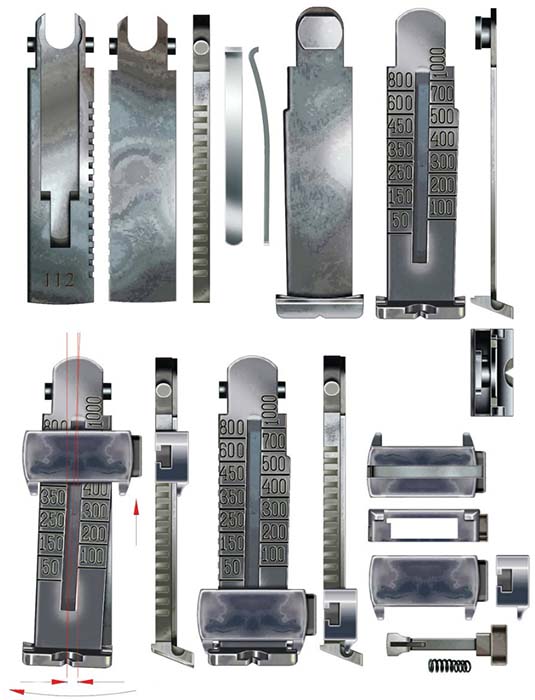
I and II Nickl’s Designs of the Yugoslav Mauser ”R-F” (Schnellfeuer, ”S”) Pistol
Considering all the noted faults as well as the verbal requirements of the Yugoslav Commission, Nickl worked out a project on the basis of which one ”Yugoslav” pistol prototype in 7.63mm calibre (No. 12,004) and another one in calibre 9mm (No. 12,003) were manufactured. The first mechanism functioning inspection took place on January 25, 1933 at the Rheinisch-Westfälische Sprengstoff AG factory near the Rottweil ammunition range. Average muzzle velocity recorded on discharging the 9mm cartridges was 343.05 m/s, and 405.6 m/s on discharging the 7.63mm ammunition. The Technical Department informed director Zillinger about these prototypes who passed the information about pistol redesigns to Colonel Petrovic, the chief of the Royal Serbian Arsenal on February 4th, ”…. Pistols Mauser 7.63mm and 9mm (Luger) now have: barrel screwed up in the slide, horizontaly adjustable front sight, tangent rear sight with the ability to adjust bullet derivation, modified 9mm detachable box magazine and slightly lower mounting of the shoulder stock.”
The Germans managed to inspect the tactical-technical features of the weapon on February 6, 1933 on the factory’s prototypes of the 7.63mm Mauser pistol No. 11,491 and on the 9mm pistols Nos. 12,140 and 12,141. The ”Wu” & ”Pr/We” Departments informed the ‘Wp” about the results on February 7, 1933: ”Target group size was slightly better than those achieved during testing on the 31st January 1933. However, it is noticeable that the 9mm pistol at 500m, and after several repetitions, the average target group size is grouped to the left, while at all other distances is grouped to the right. The new, wide front blade is better than the last. The tangent rear sight is uncontrolled and moves as in the previous test”
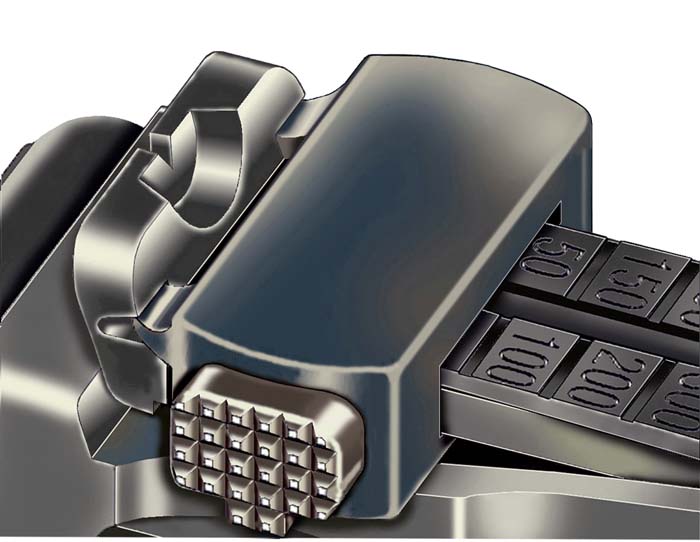
On 7 February, 1933, the Germans further test two automatic pistols in Yugoslavia. As the weapon in 7.63mm, No. 11,491 failed to satisfy all performances, they manufactured another one in the same calibre, number 12,004 instead as well as the first variant of the 9mm calibre pistol No. 12,003 instead of the 9mm pistol Nos. 12,140 and 12,141. Pistols were with the barrel screwed into the slide and the special ”Yugoslav” tangent rear sights.
On February 22, 1933, the Technical Office had a detailed description of Nickl’s ”Yugoslav” prototype (otherwise known as Yugoslav Model I). The barrel is screwed in the slide-barrel extension so that it can be changed and had a horizontally adjustable front blade as on pistol Luger P-08. In order to keep a slim form of a pistol, the chamber was located in the slide. Barrel length without chamber increased from 98mm to 117mm. Barrel length with chamber was 141.5mm.
To correct deflection of a bullet path at distances over 400 m, which is resulting from right hand twist rifling, a new type of tangent sight was created. On the sight leaf which is in height set for distances from 200 to 1,000 meters, the notch rear sight adjusts to the deflection of a bullet path on the selected distance, ie, notch rear sight is moved laterally so that is the same target group size ensured for all specified ranges. Namely, instead of the classical sight leaf made of one part, on the new tangent sight is a two-part sight leaf where the upper part was graduated with range marks in meters and have a base with a rear sight notch. The right edge of the upper part are obliquely tapering toward the base of the rear sight notch. On the left side of the lower part are slots cut in the edge for sight slider button and lug type pivot that goes into the pivot ears. The sight leaf is placed parallel with the longitudinal axis of the barrel. The upper part of the sight leaf can be rotated in the horizontal plane in relation to the lower part. The sight slider has a sight slider button and stepped hole for sight leafs. The bottom part of the hole at the sight slider slides along the upper leaf, which is parallel to the longitudinal axis of barrel, and the upper part of the hole pushed sloped side edge of upper leaf, which is sloped in relation to the longitudinal axis of barrel. Thanks to such construction, the axis of the rear sight notch and axis of sight slider at a distance of up to 50 m are located just above the longitudinal axis of barrel. During setting up for other distances, up to 1,000 m, rear sight notch in relation to the longitudinal axis of barrel moves to the left, which is the correct deflection of the bullet from the path to the right. Namely, the upper internal edge of the sight slider hole during moving the sight slider forward, pushed the sloped side edge of upper leaf and rotated, together with the rear sight notch, to the left. Thus the corrected deflection of the bullet from the path to the right, which is due to right hand twist rifling.
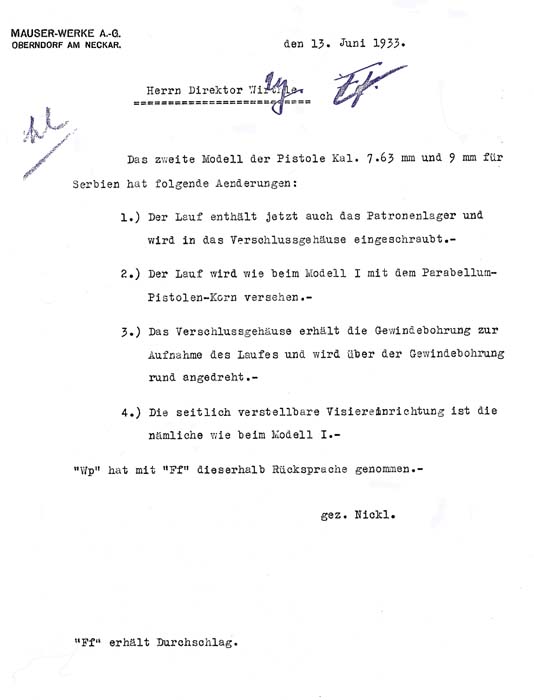
As the upper sight leaf, which at the rear was narrower than the lower sight leaf, it would not move. The rear sight slider has two teeth that were entered in the cuttings on the rear sight blade, and so fixed the whole tangent rear sight.
The front sight on the barrel is horizontally adjustable with a wide rectangular front blade from Luger P-08 pistol. The detachable shoulder stock/holster is set to 6.5 mm below, so the hammer can not hurt the hand that held butttstock grip.
The Model I pistols were tested during April at the Military-Technical Institute at Kragujevac simultaneously with several competitive designs. On May 4, 1933 Damjan Brankovic informed the Oberndorf factory managers that in competition were pistols Mauser, Astra and Bergmann.
In addition, the Commission concluded that later sent Mausers in calibre 9mm and 7.63mm were not sufficiently precise.
Certainly, the Technical Office could not be pleased with the report, and ordered the development of new, better guns. Nickl also concluded that he had to improve the first design of the ”Yugoslav” pistol. Besides, which will be seen later, due to good relations with the Yugoslav military, Brankovic and Veljovic sent the tactical-technical demands of the Ministry of Army of Yugoslavia in advance. That way, by early June of 1933, according to Nickl’s designs, another prototype of the Mauser automatic pistols intended for further trials at Kragujevac were manufactured. These were the 7.63mm Nos. 3,111 & 3,112 and 9mm Nos. 3109 & 3110. On June 13, Nickl informed Director Wirthle that the changes consist mainly in the fact that on the second ”Serbian” model pistol 7.63mm and 9mm chamber located in the barrel, the barrel is screwed into the slide, set the adjustable front blade from a Luger P-08 pistol and the adjustable rear sight is the same as in Model I.
A week later, the Ministry of Army of the Yugoslavia placed an official order for 2,000 pistols as well as the necessary tactical-technical demands to meet their requirements. Guns would be tested by a summary procedure, to 5,000 rounds.
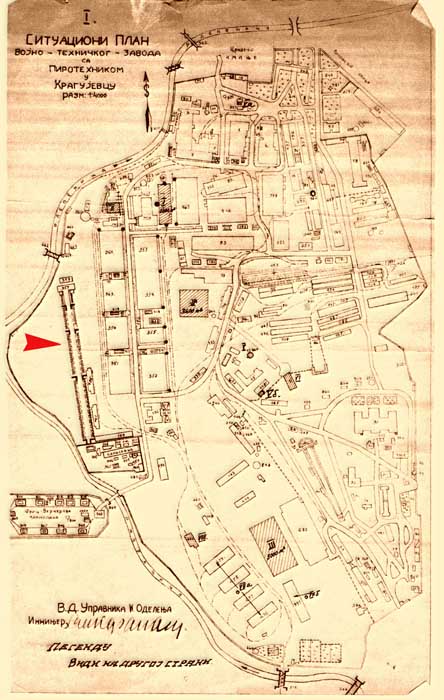
Each part of the pistol must withstand, without damage, 5,000 rounds – half in the semiautomatic mode of fire and the second half in full-automatic fire. The bolt can not unlock before the bullet travels 3/4 of the rifled part of barrel.
To fulfill these requirements, the factory concluded that all parts of steel NC II after heating at 820°C, to cool in the oil, then re-heat at 650°C and left to cool in the ashes. The extractor should be produced by modification of the original extractor with the Mauser M1898 rifle. Similarly, the firing pin also must be produced of steel from which is made the firing pin on the Mauser rifle M1898. Thus, the firing pin has been thermaly improved to the characteristics of steel NC II.
Only a day before on, September 22, 1933, Damjan Brankovic informed the Oberndorf managers about the plans and their designs which, according to his knowledge, the Ministry of the Army of Yugoslavia had chosen to inspecting. ”As we heard from high military circles, in the shortest time will be carried out new tests. On the test will be attending the following companies: Mauser Werke AG, Oberndorf; Fabrica de Armas de Fuego de Unceta y Compania (Astra) Guernica; Theodor Bergmann u. Co., Berlin; Bonifacio Eccheveria (Star) Eibar and La Société Anonyme des Anciens Etablissements Pieper (Bayard), Herstal-Liege.”
Obviously, the previously disputed Royal pistol was finally dropped out of the competition. However, in his letter Brankovic does not mention the commercial company Societé Anonyma Intercambio Commerciele from Madrid which would take part in the competition with the copy of the Mauser-Schnellfeuer pistol manufactured by Beistegui Hermanos firme SA, Eibar.
By the end of September of 1933, according to all requirements, the workers of the Oberndorf factory perfected four Mauser pistols (instead of five previously planned) with Nos. 3,111 & 3,112 in 7.63mm calibre and Nos. 3,109 and 3,110 in calibre 9mm.
The weapons were sent to Yugoslavia and the trials started in October to last until December 26, 1933 at the rifle range at Kragujevac. At the very first day of the trials it turned out that the Yugoslavs were only partly satisfied with the pistol’s preciseness, and Premauer informed the general manager Von Lossnitzer and the Technical Office about it.
Noticeably, these reports do not mention any significant improvement of the weapon’s preciseness. The pictures of the hits at the longer distances suggest that the Yugoslavs could not be happy with the results. Besides, the Belgian Grand Rendement M1928 showed itself as a favourite. Obviously, the German representatives tried to minimize the importance of this fact.
What was going on during the course of the trials can be best seen in a report of December 15th 1933 which was written by Alex Mauser in the Belgrade hotel Srpski Kralj. In these tests, participants were F.N. Herstal, with the 9mm Grand Rendement M1928 pistol, Bonifacio Eccheverria, Eibar, with 7.63mm and 9mm Star pistols, Société Anonyma Intergambio Commerciele, Madrid, with two copies of the Mauser pistol, that are by the members of the Commission, despite Alex Mauser’s opposition, called Spanish Mauser (7.63mm Pistola Ametralladora Royal MM 31 and Mauser-Werke A.G with 7.63mm and 9mm automatic pistols.
Despite the failure, Alex Mauser tried to beautify the report. Namely, Mauser-Schnellfeuer is really the only pistol that could be fired in semiautomatic and automatic mode. Both pistols offered from the Societe Anonyme Intergambio Commerciele dropped from the competition during the examination of accuracy. On the first pistol, the bolt was not locking to the barrel, and on the second gun came uncontrolled burst-firing in semiautomatic mode. Because of the same faults, the next day the 9mm Star pistol was excluded from further examination.
For testing in continuous semiautomatic firing, there remained the 9mm FN and 7.63mm Star pistols, both without the possibility for full-automatic fire, and the 7.63mm Mauser automatic pistol. This testing consisted of two parts: First, 2,000 rounds in semiautomatic mode, without pause, as long as the pistol functioned without the need for cleaning and measurement of the angluar dispersion of a series of rounds from 200 m, and second, 2,500 rounds in full-automatic mode – after every 20 rounds a 2 minute pause. Measurement of of the angluar dispersion of a series of rounds from 200 m, number of successfully fired rounds without cooling weapons, and a list of all observed stoppages.
The FN pistol endured the test without damage, and was not observed with any significant wear of parts. However, the barrel was completely worn out. After 500 rounds the trigger was so hot, that further shooting was impossible. Finally, after 4,500 rounds there were recordings of 29 jams.
The Spanish Star pistol fired the first 2,000 rounds with 4 jams. However, after 3,000 rounds, there appeared consecutive jamming. The extractor was broken and, after installing a new extractor, cases were jammed, and after 3,500 rounds the pistol ceased to function.
With the Mauser pistol, during semiautomatic fire, the bolt was not loading a round from the magazine into the chamber and not extracting and ejecting the shell casing. The situation was bettter when the pistol was loaded from a stripper clip. After 800 rounds, the extractor was broken.
Test in full-auto fire mode was passed with 4 jams: after 1,000 rounds the extractor was broken, then the safety lever, and, finally the firing pin was also broken. All other parts were without damage.
That same evening (December 15, 1933) Mr Veljovic said to Alex Mauser that Yugoslavia was planning to order for the mountain troops at least 45,000 pistols and for this purpose it approved a secret loan of 200 million dinars. But soon they found that the information was false.
After the Germans had offered Yugoslav Prime Minister Stojadinovic the clearing payment of dept to be solved by military material deliveries, during 1935, the Ministry of the Army reconsidered very seriously the idea to obtain Mauser Schnellfeuer pistols. In September of 1935 a staff major Béthouart, French military attaché in Yugoslavia, informed the French Intelligence Service that the Yugoslavs were negotiating the purchase of the Mauser Schnellfeuer pistols. Nevertheless, the Military-Technical Committee finally realized that this weapon was unsuitable for Special Task Units, particularly for the Mountain Troops. That way, the issue of the purchase of the Mauser automatic pistol was put ”ad acta” again. This meant that Yugoslavia never officially purchased this type of weapon until 1941, with exception of the pieces intended for trials at the Military-Technical Institute at Kragujevac.
As far as we know, until now have been saved only two of the Yugoslav Model ”R-F” Mauser pistols: pistols Nos. 3,109 & 3,112 as, we have seen, are in the Mr. Gousset collection.
Tactical – technical data:
Caliber: 7.63 mm
Overall Length: 296.5+1.5 mm
Maximal Width: 36 mm
Maximal Height: 150 mm
Barrel length: 117 mm
Barrel length with chamber: 141.5 mm
Distance between front and rear sights: 247 mm
Number of grooves: 6
Twist rate (right-hand twist): 200 mm
Weight of Pistol
With empty 10-round detachable box magazine (100 gr): 1.30 kg
With empty 20-round detachable box magazine (150 gr): 1.35 kg
Length of detachable shoulder stock/holster: 355 mm
Weight of detachable shoulder stock/holster: 460 gr
Length of pistol with detachable shoulder stock/holster: 630 gr
Weight of pistol with detachable shoulder stock/holster: 1760 gr
Muzzle velocity (Vo): 430 m/s.
Muzzle energy (Eo): 50.5 m/kg.
Sight Range: 1,000 m
Maximum range: 2,000 m
Bullet penetration (Fir) from 50 m: 20-22 cm
Rate of fire/min
Semi-auto, with change of box magazine: 60 rds
Full-auto: 120 rds
| This article first appeared in Small Arms Review V16N3 (September 2012) |











